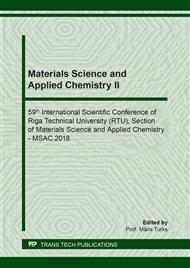[1]
E.A. Dil, M. Ghaedi, A.M. Ghaedi, A. Asfaram, A. Goudarzi, S. Hajati, M. Soylak, S. Agarwal and V.K. Gupta, Modeling of quaternary dyes adsorption onto ZnO-NR-AC artificial neural network: Analysis by derivative spectrophotometry, J. Ind. Eng. Chem. 34 (2016) 186-197.
DOI: 10.1016/j.jiec.2015.11.010
Google Scholar
[2]
J. Gómez, J. Galán, A. Rodríguez and G. Walker, Dye adsorption onto mesoporous materials : pH influence, kinetics and equilibrium in buffered and saline media, J. Environ. Manage. 146 (2014) 355-361.
DOI: 10.1016/j.jenvman.2014.07.041
Google Scholar
[3]
A. Gil, F.C.C. Assis, S. Albeniz and S.A. Korili, Removal of dyes from wastewaters by adsorption on pillared clays, Chem. Eng. J. 168 (2011) 1032-1040.
DOI: 10.1016/j.cej.2011.01.078
Google Scholar
[4]
A. Iddou and M.S. Ouali, Waste-activated sludge (WAS) as Cr(III) sorbent biosolid from wastewater effluent, Colloids Surfaces B Biointerfaces. 66 (2008) 240-245.
DOI: 10.1016/j.colsurfb.2008.06.018
Google Scholar
[5]
A. Iddou, M. Hadj Youcef, A. Aziz and M.S. Ouali, Biosorptive removal of lead (II) ions from aqueous solutions using Cystoseira stricta biomass: Study of the surface modification effect, J. Saudi Chem. Soc. 15 (2011) 83-88.
DOI: 10.1016/j.jscs.2010.10.007
Google Scholar
[6]
H. Aguedal, H. Hentit, D.R. Merouani, A. Iddou, A. Shishkin and J.C. Jumas, Improvement of the sorption characteristics of diatomite by heat treatment, Key Eng. Mater. 721 (2017) 111-116.
DOI: 10.4028/www.scientific.net/kem.721.111
Google Scholar
[7]
A. Djafer, S. Kouadri Moustefai, A. Iddou and B. Si Ali, Study of bimacid dye removal from aqueous solution: a comparative study between adsorption on pozzolana, bentonite, and biosorption on immobilized anaerobic sulfate-reducer cells, Desalin. Water Treat. 52 (2014) 7723-7732.
DOI: 10.1080/19443994.2013.833866
Google Scholar
[8]
A. Shishkin, V. Mironovs, V. Lapkovskis, J. Treijs and A. Korjakins, Ferromagnetic sorbents for collection and utilization of oil products, Key Eng. Mater. 604 (2014) 122-125.
DOI: 10.4028/www.scientific.net/kem.604.122
Google Scholar
[9]
A. Shishkin, A. Laksa, V. Shidlovska, Z. Timermane, H. Aguedal, V. Mironovs and J. Ozolins, Illite clay ceramic hollow sphere - obtaining and properties, Key Eng. Mater. 721 (2017) 316-321.
DOI: 10.4028/www.scientific.net/kem.721.316
Google Scholar
[10]
S. Benhammadi, A. Shishkin, A. Iddou, H. Aguedal and L.C. De Menorval, Adsorption of lead (II) in liquid-solid interfaces on natural and modified hydroxyapatite, Key Eng. Mater. 721 (2017) 117-122.
DOI: 10.4028/www.scientific.net/kem.721.117
Google Scholar
[11]
B. Yahyaei and S. Azizian, Rapid adsorption of binary dye pollutants onto the nanostructred mesoporous alumina, J. Mol. Liq. 199 (2014) 88-95.
DOI: 10.1016/j.molliq.2014.08.023
Google Scholar
[12]
H. Aguedal, A. Iddou, A. Aziz, A. Shishkin, J. Locs and T. Juhna, Effect of thermal regeneration of diatomite adsorbent on its efficacy for removal of dye from water, Int. J. Environ. Sci. Technol. (2018) Article in press.
DOI: 10.1007/s13762-018-1647-5
Google Scholar
[13]
H. Aguedal, A. Iddou and J. Locs, Optimization of the adsorption process of bezaktiv turquoise blue «VG» textile dye onto diatomite using the Taguchi method, Key Eng. Mater. 762 (2018) 81-86.
DOI: 10.4028/www.scientific.net/kem.762.81
Google Scholar
[14]
N. Abdehagh, F.H. Tezel and J. Thibault, Multicomponent adsorption modeling: isotherms for ABE model solutions using activated carbon F-400, Adsorption. 22 (2016) 357-370.
DOI: 10.1007/s10450-016-9784-y
Google Scholar
[15]
M. Anggraini, A. Kurniawan, L.K. Ong, M.A. Martin, J.C. Liu, F.E. Soetaredjo, N. Indraswatia and S. Ismadji, Antibiotic detoxification from synthetic and real effluents using a novel MTAB surfactant- montmorillonite (organoclay) sorbent, R. Soc. Chem. Adv. 4 (2014) 16298-16311.
DOI: 10.1039/c4ra00328d
Google Scholar
[16]
S. Ziane, F. Bessaha, K. Marouf-Khelifa and A. Khelifa, Single and binary adsorption of reactive black 5 and Congo red on modified dolomite: performance and mechanism, J. Mol. Liq. 249 (2018) 1245-1253.
DOI: 10.1016/j.molliq.2017.11.130
Google Scholar


